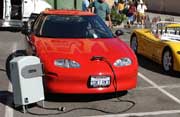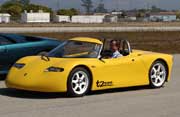


These vehicles are truly zero-emitting; they are powered by the sun.
In 1998 we analyzed the economics of adding a photovoltaic system to our home. At the time, we decided against it for a number of reasons, not the least of which is that it didn't appear to make financial sense. At the time, there was also a 10kW limit on residential photovoltaic systems that qualified for net-metering. Those systems that didn't qualify were hit with large charges to interconnect and were not permitted to store excess power in the grid for use at night. We didn't want a half solution to our problem, and the 10kW limit was a problem.
In 1999 my wife and I leased our first battery-electric car, a 1997 General Motors EV1. Although we didn't expect this little red car to change the world, it sure changed our lives. Our initial interest in the car was environmental, and we thought that by driving this electric car we'd be making some sacrifices to do something for the environment. We quickly came to the conclusion that electric cars are just better cars and we both fought over who would drive it. In early 2000 we added a second EV1 to the family, and at one point had four electric cars: two General Motors EV1s, a Toyota RAV4-EV, and an AC Propulsion tzero. When the lease expired on our GM EV1s, General Motors refused to sell us the cars and demanded their return so that the cars could be destroyed (see www.saveev1.org). We have since added a second RAV4-EV to our "fleet".



These vehicles are truly zero-emitting; they are powered by the sun.
These cars attract a lot of questions and one of the common question is
"Haven't we just moved our pollution to the power plant?"
.
Well, no we haven't. The emissions (excluding Carbon Dioxide) generated
at the power plant are approximately 3% of the tailpipe emissions of
an equivalent gasoline car, and that doesn't even count the upstream
emissions associated with the extraction, refining, and transporation
of gasoline.
The upstream Carbon Dioxide emissions from an electric vehicle
are only mildly better than the best
gasoline-fueled vehicles; indeed the most efficient
gasoline-fueled vehicle, the Honda Insight, emits about the same as the General
Motors EV1. Never the less, these questions started us thinking towards a
cleaner way to generate power for our electric vehicles.
A second look at photovoltaics showed them beginning to make economic sense. Costs had come down and the subsidies increased. We calculated an 18-year payback and a 30-year lifetime on our system. In the fall of 2000, San Diego's electric company was already fully deregulated and retail electric rates in San Diego soared. We knew that it was almost a matter of time before Pacific Gas & Electric's rates did the same. A doubling of retail electric rates would bring the payback period down to under 10 years. Assemblyman and then-Speaker pro tem of the California Assembly, Fred Keeley had introduced a bill to remove the 10kW cap on renewable energy systems. Things were looking up for solar, and we started the design and construction of what became a 30.5kW photovoltaic system to power our house and cars.
I won't go into detail here as to how to do your own analysis of the economics of a photovoltaic system, as there are many variables such as climate and state law. Home Power Magazine is an excellent resource that can help you determine if a photovoltaic system is right for you. Check out the various incentives available, on a state by state basis. California Energy Commission has an excellent site with a Clean Power Cost Estimator.
This page is supported by Adelman@Adelman.COM - Kenneth Adelman